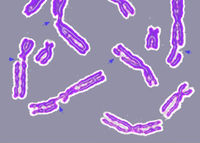
An image of several chromosomes with some being incomplete because they are damaged.
Maintenance of the accuracy of the DNA genetic code is critical for both the long- and short-term survival of cells and species. Sometimes, normal cellular activities, such as duplicating DNA and making new gametes, introduce changes or mutations in our DNA. Other changes are caused by exposure of DNA to chemicals, radiation, or other adverse environmental conditions. No matter the source, genetic mutations have the potential for both positive and negative effects on an individual as well as its species.
A positive change results in a slightly different version of a gene that might eventually prove beneficial in the face of a new disease or changing environmental conditions. Other mutations are considered deleterious, or result in damage to a cell or an individual. For example, errors within a particular DNA sequence may end up either preventing a vital protein from being made or encoding a defective protein. It is often these types of errors that lead to various disease states.
The potential for DNA damage is counteracted by a vigorous surveillance and repair system. Within this system, there are a number of enzymes capable of repairing damage to DNA. Some of these enzymes are specific for a particular type of damage, whereas others can handle a range of mutation types. These systems also differ in the degree to which they are able to restore the normal, or wild-type, sequence.[1]
Types of Repair Systems
- Photoreactivation is the process whereby genetic damage caused by ultraviolet radiation is reversed by subsequent illumination with visible or near-ultraviolet light.
- Nucleotide excision repair is used to fix DNA lesions, such as single-stranded breaks or damaged bases, and occurs in stages. The first stage involves recognition of the damaged region. In the second stage, two enzymatic reactions serve to remove, or excise, the damaged sequence. The third stage involves synthesis by DNA polymerase of the excised nucleotides using the second intact strand of DNA as a template. Lastly, DNA ligase joins the newly synthesized segment to the existing ends of the originally damaged DNA strand.
- Recombination repair, or post-replication repair, fixes DNA damage by a strand exchange from the other daughter chromosome. Because it involves homologous recombination, it is largely error free.
- Base excision repair allows for the identification and removal of wrong bases, typically attributable to deamination—the removal of an amino group (NH2)—of normal bases as well as from chemical modification.
- Mismatch repair is a multi-enzyme system that recognizes inappropriately matched bases in DNA and replaces one of the two bases with one that "matches" the other. The major problem here is recognizing which of the mismatched bases is incorrect and therefore should be removed and replaced.
- Adaptive/inducible repair describes several protein activities that recognize very specific modified bases. They then transfer this modifying group from the DNA to themselves, and, in doing so, destroy their own function. These proteins are referred to as inducible because they tend to regulate their own synthesis. For example, exposure to modifying agents induces, or turns on, more synthesis and therefore adaptation.
- SOS repair or inducible error-prone repair is a repair process that occurs in bacteria and is induced, or switched on, in the presence of potentially lethal stresses, such as UV irradiation or the inactivation of genes essential for replication. Some responses to this type of stress include mutagenesis—the production of mutations—or cell elongation without cell division. In this type of repair process, replication of the DNA template is extremely inaccurate. Obviously, such a repair system must be a desperate recourse for the cell, allowing replication past a region where the wild-type sequence has been lost.[2]
References